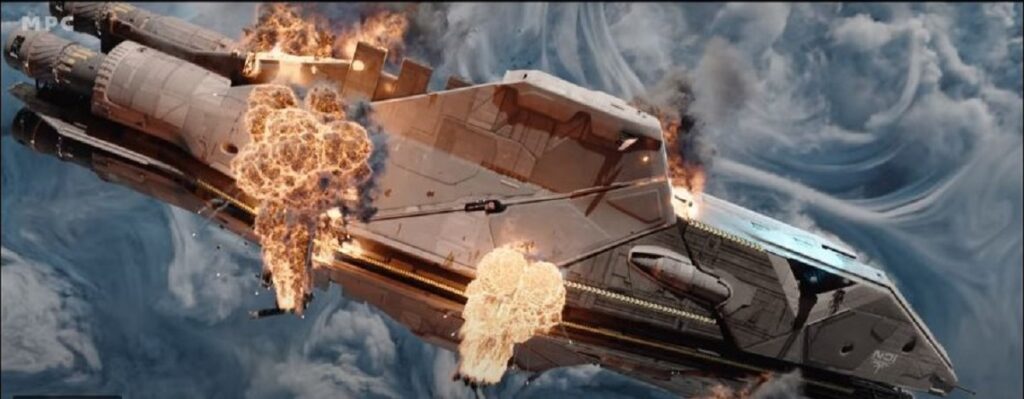Visual effects giant MPC oversaw 825 artists to deliver 266 shots for sci-fi action film Atlas. Their VFX team led by supervisor Luc-Ewen Martin-Fenouillet and VFX producers Ryan Valde and Emma Gorbey, worked closely with film’s director Brad Peyton, production VFX supervisor Lindy DeQuattro, and VFX producer Blondel Aidoo.
MPC’s work was varied, creating full CG environments as well as set extensions, spaceships, digital doubles, and FX simulations for epic battle sequences.
The team’s most challenging sequence was the ‘Planet Fall’. This choreographed free fall from a spaceship in low orbit to a crash landing on the planet’s surface required meticulous planning and execution. The sequence captured the chaos and intensity of a continuous fall, with mechs battling drones amidst a dynamic and ever-changing environment.
“We mapped a fall path from low orbit to the planet’s surface for the action to take place, resulting in a scene covering several dozen kilometres,” said MPC VFX supervisor Luc-Ewen Martin-Fenouillet. “Atlas, in her Arc Suit, needed to start falling above the clouds, then enter an electric storm, and finally emerge right above the alien planet’s surface. To manage the scale, we created low-resolution geometries of clouds to have a faithful representation of the image composition without having to simulate volumes. Once the animation was blocked, we converted those geometries to cloud shapes, categorised by altitude. This way, cirrostratus remained only at high altitude while stratocumulus were found only at low altitude. This approach provided a subtle yet flexible way to tell the free-fall story of the sequence through cloud shapes.”
MPC’s artists also transformed Los Angeles and Hong Kong into futuristic metropolises with giant hologram projections, massive mega-structures, and flying vehicles. Eight full-CG shots were created for the space flight between LA and the security gates outside Earth’s atmosphere. Significant effort was devoted to developing the security mesh that shields the planet from AI invasion, ensuring it felt tangible and coherent with the human technology depicted in the film.
The set of the giant military spaceship, the Dhiib, was extended to include additional bays, CG engineers, and soldiers. This sequence featured a dramatic ambush from AI forces, fracturing the armoury and creating a chaotic environment with flames and flying embers.
For Centurion Camp, MPC enhanced a real location, a disused factory, into a well-protected camp inside a thick tropical jungle. The sequence, set under rainy conditions, featured CG overgrown vegetation, looming cliffs, and robot interactions with plants, with simulated droplets splashing on alien leaves and flowers.
To achieve this, the production design team built a modular Arc Suit cockpit rig capable of orbiting in all directions. MPC motion-tracked the cockpit and camera to seamlessly integrate the practical plate into CG Arc Suits. This innovative projection rig provided the flexibility needed for robot animation and dynamic camera movements throughout the film.
“Atlas was a really fun challenge for our artists,” said Martin-Fenouillet. “There were so many different sorts of effects to create, but our director Brad Peyton had an extremely clear vision and understanding of VFX, which really helped with the work.” Valuing creativity, Peyton gave MPC team the freedom to innovate and enhance the visual narrative.

